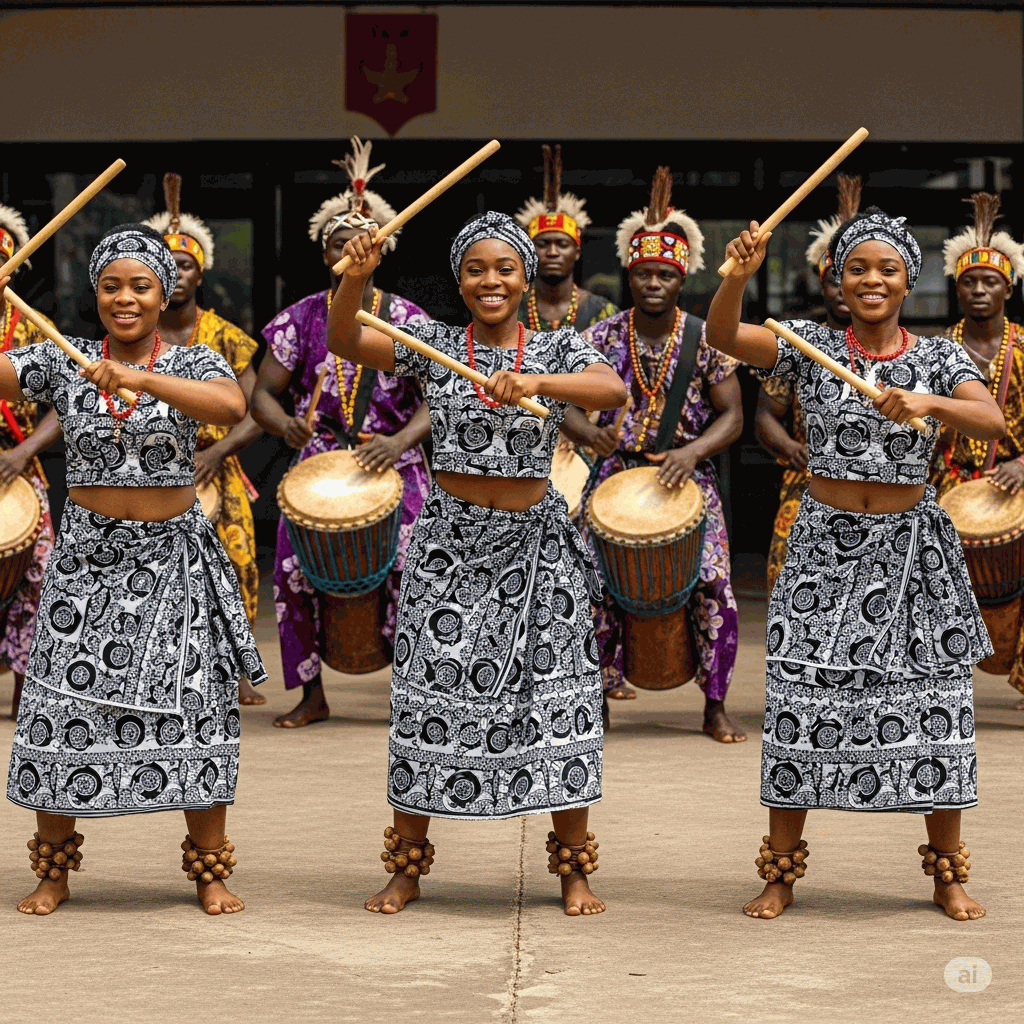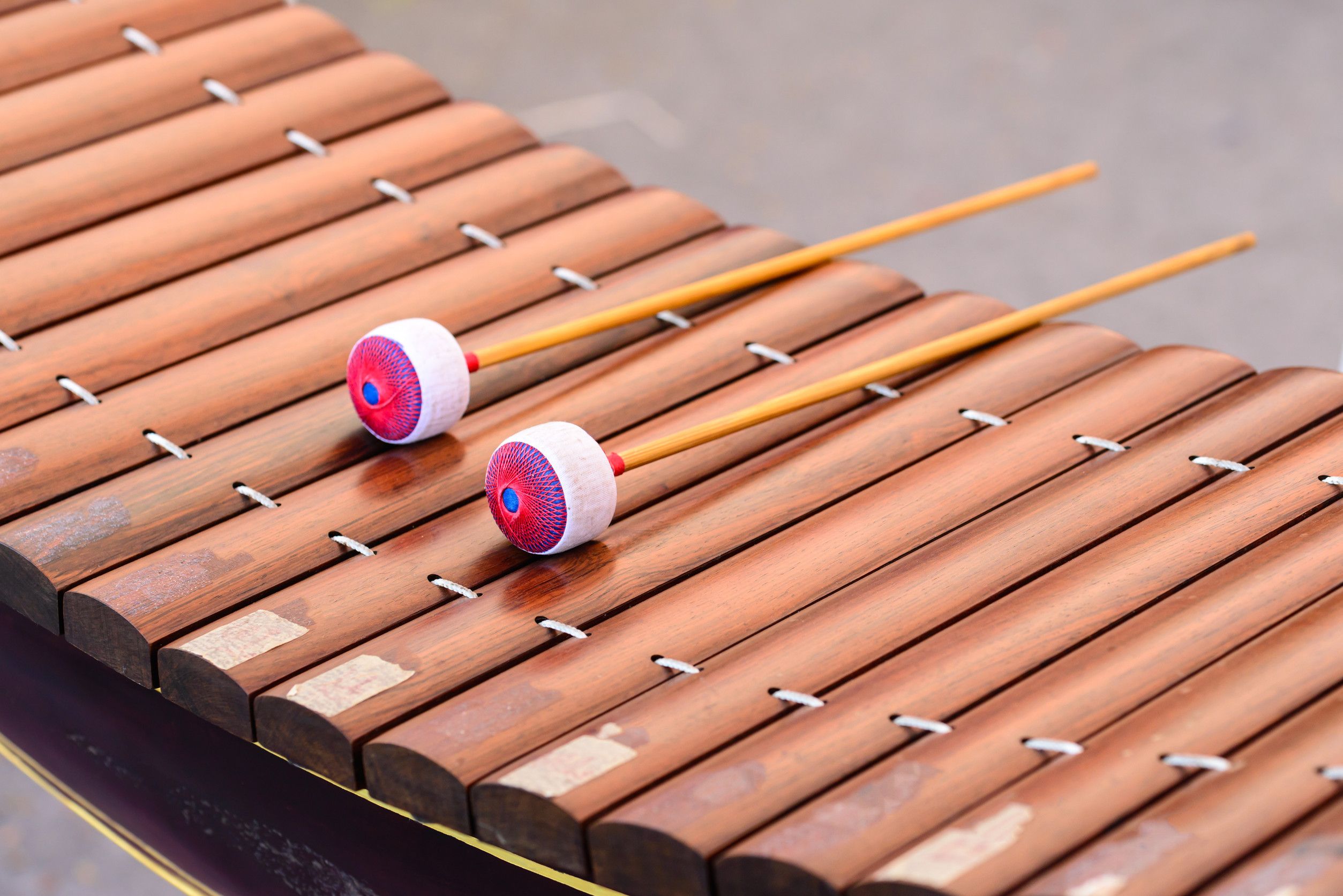An Exploration of Cameroon’s Music & Dance Culture

Cameroon is a country full of color and energy, shaped by the traditions of more than 250 ethnic groups. This incredible diversity comes alive most vividly through its music and dance. Whether it's the deep, spiritual rhythms of forest ceremonies or the lively beats echoing through city nightclubs, every performance tells a story—connecting the old with the new. In this guide, we’ll explore the sounds, movements, and cultural expressions that form the vibrant heartbeat of Cameroon.
🎵 Overview of Traditional Music Genres in Cameroon
Cameroon's traditional soundscape is a mosaic of its ethnic diversity. In the Grassfields region, the Bamileke and Bamoun are known for intricate polyrhythms and music tied to royal courts and secret societies, often featuring xylophones and large drum ensembles. The Beti people of the Center region have given the world the rhythmic foundation for Bikutsi, traditionally featuring the mvet (a stringed instrument) and choral singing. Along the coast, the Sawa people's music, like the spiritual chants of the Ngondo festival, is deeply connected to water. In the forested South and East, the music of peoples like the Baka is characterized by complex vocal polyphony and yodeling, often using water drumming as a percussive element.
The Role of Drums and Percussion in Cameroonian Culture
In Cameroon, drums are more than just rhythmic instruments; they are the society's pulse. They speak languages, summon spirits, announce royal decrees, and gather communities. The "talking drum," used by various ethnic groups, can replicate the tonal patterns of speech to send complex messages across villages. Large log drums, slit drums, and an array of hand drums like the djembe are central to every ceremony. The rhythms are not merely for dancing but are codified systems of communication that convey history, social status, and spiritual intent.
Exploring the Balafon: Cameroon’s Signature Xylophone

The balafon is one of Africa’s most iconic melodic percussion instruments, and it holds a special place in Cameroon. This wooden xylophone, with gourds of varying sizes fixed beneath the keys to act as natural resonators, produces a warm, buzzing sound. Its construction is an art form, with the wood and gourds carefully selected to achieve precise pitches. In Bamileke and Bamoun cultures, the balafon is a lead instrument in orchestras, often played by master musicians who are also historians, using its melodies to narrate epic genealogies and community legends.
How Traditional Music Reflects Ethnic Diversity in Cameroon
The musical styles across Cameroon are a direct reflection of its varied geography and ethnolinguistic landscape.
- The Grassfields (West/Northwest): Music is often stately and complex, reflecting monarchical social structures. It features large ensembles of drums, balafons, and flutes, accompanying masked dances.
- The Forest Regions (Center/South/East): Beti, Baka, and Fang music is characterized by intricate vocal harmonies and fast-paced, interlocking rhythms. The mvet, a harp-zither, is a key narrative instrument for Beti storytellers.
- The Coastal Regions (Littoral/Southwest): The music of the Sawa (Duala, Bakweri) is often tied to the sea and ancestral water spirits. Genres like Ambas-i-bay and Assiko originated here, blending percussive rhythms with guitar.
- The Sahelian North: Influenced by Islamic traditions, the music here features stringed instruments like the garaya (lute) and monochords, with praise-singing being a dominant vocal style.
The Spiritual and Ceremonial Significance of Music in Cameroonian Tribes
Music is the conduit between the physical and spiritual worlds. In healing ceremonies, specific rhythms are used to invoke benevolent spirits or exorcise negative energies. During funeral rites, music guides the soul of the deceased to the ancestral realm while providing catharsis for the living. Secret societies, such as the Ku'ngang of the Bamileke, use sacred instruments and chants that are forbidden to be heard by the uninitiated, believing the sounds themselves hold supernatural power.
10 Traditional Cameroonian Dances and Their Meanings
In Cameroon, dance is more than physical expression—it is communication. Dances are structured, purposeful, and steeped in cultural meaning. Each ethnic group has its own repertoire, often passed down generations.
|
Dance |
Ethnic Group/Region |
Description & Meaning |
|
Bikutsi |
Beti (Central Region) |
Energetic, hip-swaying dance performed by women; originally used to celebrate births and convey storytelling, often with bold, expressive lyrics. |
|
Assiko |
Bassa (Littoral Region) |
Features intricate footwork with dancers balancing bottles on their heads; showcases agility, performed to guitar and percussion rhythms. |
|
Ambas-i-bay |
Sawa (Coastal Region) |
Gentle, swaying dance mimicking ocean waves; a key precursor to Makossa, reflecting the maritime culture of the Sawa people. |
|
Njang |
Northwest Region |
Graceful and rhythmic with stomping, rattles, and flutes; used to celebrate heritage, unity, and community spirit. |
|
Ku'ngang |
Bamileke (Grassfields) |
Sacred masked dance performed at funerals of leaders; enforces social order and guides spirits to the afterlife. |
|
Gome |
Grassfields (Western Region) |
Warrior dance involving mock combat and synchronized stomps to display strength, discipline, and valor. |
|
Lali |
Bamoun (West Region) |
High-energy dance with athletic jumps; performed by young men during festivals to demonstrate power and attract mates. |
|
Bottle Dance |
Various (notably Bassa) |
Balancing bottles while dancing as a symbol of control and poise; often overlaps with Assiko in performance style. |
|
Sama |
Fulani (Northern Cameroon) |
Graceful and elegant, involves flowing robes and expressive hand gestures; performed during cultural celebrations. |
|
Baka Forest Dances |
Baka (Southeastern Rainforest) |
Ritualistic dances like the Ejengi, performed to connect with forest spirits; deeply spiritual and nature-oriented. |
The Power of Dance in Birth, Marriage, and Death Ceremonies
Dance is a fundamental rite of passage in Cameroon. At birth, dances celebrate the arrival of a new life and lineage continuation. Weddings are marked by joyous communal dances where families unite and bless the new couple. Funerals, however, feature the most profound dance rituals. These dances are not just expressions of grief; they are a structured process of mourning, celebrating the deceased's life, and ritually severing their ties to the living world to ensure their peaceful transition to becoming an ancestor.
Dances of the Grassfields: Bamileke and Bamoun Ritual Movements
The Grassfields region of western Cameroon, home to the Bamileke and Bamoun peoples, is known for its powerful and symbolic masked dances. These dances are not just entertainment—they are sacred rituals with deep spiritual and cultural meaning. Masks used in the performances represent ancestors, animals, or important social figures. When dancers wear them, they are believed to take on the spirit of the character, acting as a link between the living and the spiritual world. Movements like stomps, turns, or arm gestures all carry specific meanings, understood by members of the community. These dances are usually accompanied by traditional drums, flutes, and chants, creating a rhythm that guides the dancers and connects everyone present.
In royal courts, dance is also a form of political and historical expression. Special royal dances, often performed during festivals or ceremonies, help reinforce the authority of the king, or Fon, and tell stories of the kingdom’s past. Elaborate costumes made with beads, feathers, and animal skins add to the visual power of the performance. Through these dances, the people of the Grassfields pass down traditions, honor their ancestors, and strengthen community bonds. They remain an important part of Cameroonian identity and cultural pride.
The Ngondo Festival Dances of the Sawa People in Cameroon
The Ngondo is a grand annual water festival held by the Sawa people in Douala. It is a celebration of their culture and a communion with the water spirits (jengu). The festival culminates in a ceremony on the banks of the Wouri River, featuring boat races, traditional wrestling, and sacred dances. The dances are fluid and graceful, often performed by priestesses and initiates, serving to purify the community and seek blessings from the ancestors who reside in the water.
How Dance is Used for Storytelling in Cameroonian Folklore
Long before written language was widespread, dance was a primary medium for historical documentation and education. Accompanied by agriot (storyteller/musician), dancers enact myths of creation, heroic battles, and the trickster tales of animals like the tortoise and the rabbit. Through mime, gesture, and symbolic props, entire epics are conveyed, ensuring that the folklore and values of the community are passed down through generations in a dynamic and memorable way.
The Rise of Makossa: Cameroon’s Iconic Urban Sound
Makossa, which means “to dance” in the Duala language, emerged in the 1960s from the vibrant, multicultural city of Douala and quickly became one of Cameroon’s most influential musical styles. Rooted in the traditional rhythms of the coastal Sawa people—particularly dances like Ambas-i-bay—Makossa was born out of a natural fusion between local traditions and foreign influences such as Congolese Rumba, highlife, funk, and jazz. As Cameroonians embraced urban life in the post-independence era, Makossa provided a modern, cosmopolitan sound that reflected their changing identity.
Characterized by its syncopated basslines, soulful brass sections, and intricate guitar riffs, Makossa was made for movement. The genre thrived in dancehalls and on radio stations, becoming synonymous with celebration, modernity, and national pride. Its lyrical themes often addressed love, daily struggles, and urban social issues, making it both entertaining and relatable. Over time, Makossa crossed borders, influencing and blending with genres across Africa, the Caribbean, and even Western pop. Today, it remains a cornerstone of Cameroonian musical identity and a lasting symbol of the country’s creativity and cultural innovation.
Bikutsi Beats: From Beti Origins to Global Clubs
While Makossa ruled the cities, Bikutsi was bubbling up from the forest heartland of the Beti people. It is defined by a frantic, high-tempo 6/8 rhythm that mirrors the traditional interlocking percussion. Modern Bikutsi was electrified in the 1980s by the iconic band Les Têtes Brûlées, who shocked audiences with their shaved heads, body paint, and virtuosic guitar playing that mimicked the sound of the balafon. Artists like Anne-Marie Nzié and K-Tino ("Mama Tino") further popularized its raw, earthy energy and often provocative lyrical themes.
Afrobeats & Afro-Fusion: Cameroon’s Youth Taking the Lead
The 21st century has seen a new wave of Cameroonian artists embrace a pan-African sound. While rooted in Makossa and Bikutsi, this new generation, often dubbed "Afro-bikutsi" or "Coladera," expertly fuses local rhythms with Nigerian Afrobeats, R&B, dancehall, and pop. This sound is slick, melodic, and designed for a digital, global audience. Artists like Stanley Enow, who broke through with "Hein Père," and singers Locko, Mr. Leo, and Daphne ("Calée") dominate the charts with this modern, hybrid sound.
Top Cameroonian Music Artists Making Waves Today
Here are some of the top Cameroonian music artists making waves today, spanning genres like Afrobeats, Afro-pop, hip‑hop, and gospel:
- Libianca: Her viral hit "People" made her a global phenomenon, showcasing a soulful R&B style infused with African sensibilities.
- Salatiel: A prolific singer, producer, and label owner, he gained international fame for his feature on Beyoncé's "The Lion King: The Gift" album.
- Tayc: A French artist of Cameroonian descent, his smooth Afro-love sound has made him a superstar across Africa and Europe.
- Charlotte Dipanda: A standard-bearer for modern Makossa and acoustic folk, celebrated for her powerful vocals and poignant songwriting.
- Richard Bona: A world-renowned Grammy-winning jazz bassist and singer who masterfully fuses jazz with the rhythms and languages of his native Cameroon.
How Cameroonian Artists Blend Traditional Sounds with Modern Genres
Fusion is the essence of modern Cameroonian music, where ancient rhythms meet contemporary styles to create something both globally relevant and deeply rooted in heritage. Across the country’s diverse musical landscape, artists are reimagining traditional forms—such as Bikutsi, Makossa, Assiko, and Mbolé—by blending them with genres like jazz, R&B, Afrobeats, hip-hop, reggae, and electronic dance music.
This creative alchemy often starts with language: many performers sing or rap in indigenous tongues like Duala, Ewondo, Bassa, Fulfulde, or Pidgin English, preserving linguistic identity while appealing to diverse audiences. Instrumentally, traditional tools like thebalafon (wooden xylophone), tam-tam (talking drum), and ngoma (bass drum) are frequently sampled, looped, or recorded live alongside digital synthesizers, trap beats, and electric guitars. The result is a layered soundscape that maintains the call-and-response structure and polyrhythmic foundations of traditional Cameroonian music, while embracing the textures and tempos of global pop culture.
This blend is not merely musical—it’s cultural storytelling in motion. Through rhythm and rhyme, artists reflect on identity, community, urban life, and social change. Whether performed in urban nightclubs, on social media, or during village festivals, this musical hybridity resonates across generations. It is proof that Cameroonian music is not frozen in time; it is dynamic, evolving, and perfectly poised between the ancestral and the modern.
Top Music & Dance Festivals to Attend in Cameroon
Here’s a list of the Top Music & Dance Festivals to Attend in Cameroon, each offering a rich mix of tradition, modernity, and community spirit.
- Ngondo Festival (Douala, December): The premier cultural festival of the Sawa people, celebrating water traditions.
- Festival National des Arts et de la Culture (FENAC): A major government-sponsored biennial event that brings together artists and dancers from all ten regions.
- Nyem-Nyem Festival (Ngaoundéré, July): Commemorates the resistance of the Nyem-Nyem people against German colonization, featuring impressive horse displays and traditional music.
- Mois de la Culture Bamiléké (Various locations): A month-long celebration of Bamileke culture with dances, music, and art.
The Impact of Media and Radio on Promoting Local Artists
Radio remains the most powerful medium for music discovery in Cameroon, with stations like CRTV, RFI, and a host of private channels shaping the airwaves. Television channels like Trace Africa and Boom TV play a massive role in popularizing music videos. The rise of digital media and streaming platforms like Spotify and Boomplay is slowly changing the landscape, offering artists a direct route to their audience, though internet penetration remains a challenge.
Women in Cameroonian Music and Dance: Breaking Boundaries
Although Cameroon’s music and dance industries have long been dominated by men, women have always played a vital—if sometimes underrecognized—role in shaping the cultural landscape. From traditional settings to contemporary stages, women have served as powerful storytellers, cultural custodians, and innovators. In many ethnic groups, women lead ceremonial dances tied to life events such as birth, marriage, and harvest. These performances are not only expressions of beauty and grace but also carry social, historical, and spiritual meaning. Women's dances often serve to pass down oral history, offer moral instruction, or mark rites of passage within the community.
In the modern music scene, women continue to challenge norms and claim space in new and dynamic ways. They are not only vocalists but also songwriters, producers, entrepreneurs, and cultural ambassadors. Many have used their platforms to address social issues such as gender inequality, domestic violence, and education for girls, weaving activism into their art. Their presence is reshaping public perceptions of leadership in the creative industries. Through their talent and resilience, they are redefining what it means to be a woman in Cameroonian music and dance—pushing boundaries, inspiring future generations, and contributing to a more inclusive cultural narrative.
How Music and Dance Foster National Unity in a Diverse Nation
In a country with deep linguistic (Anglophone/Francophone) and ethnic divides, music and dance are powerful unifying forces. The national football team, the Indomitable Lions, is a key symbol of unity, and the songs that celebrate them are embraced by all Cameroonians. When a Makossa song plays in Yaoundé or a Bikutsi beat drops in Bamenda, regional identities blur on the dance floor. Music transcends language barriers, creating a shared national rhythm and proudly broadcasting the collective identity of "Africa in Miniature" to the world.
Disclaimer: While this information was last updated in June 2025, we strongly suggest confirming all travel details with the appropriate governmental agencies, embassies, and airlines.
Applying for a Cameroon eVisa
- Step 1: Complete the online application form with your personal details and passport information.
- Step 2: Proceed to securely pay online using your credit card.
- Step 3: Check your email for payment confirmation and receipt of your Cameroon eVisa, which will be sent electronically.

